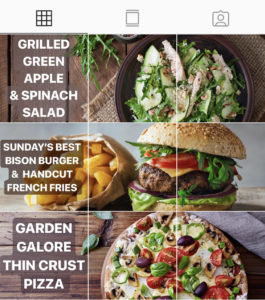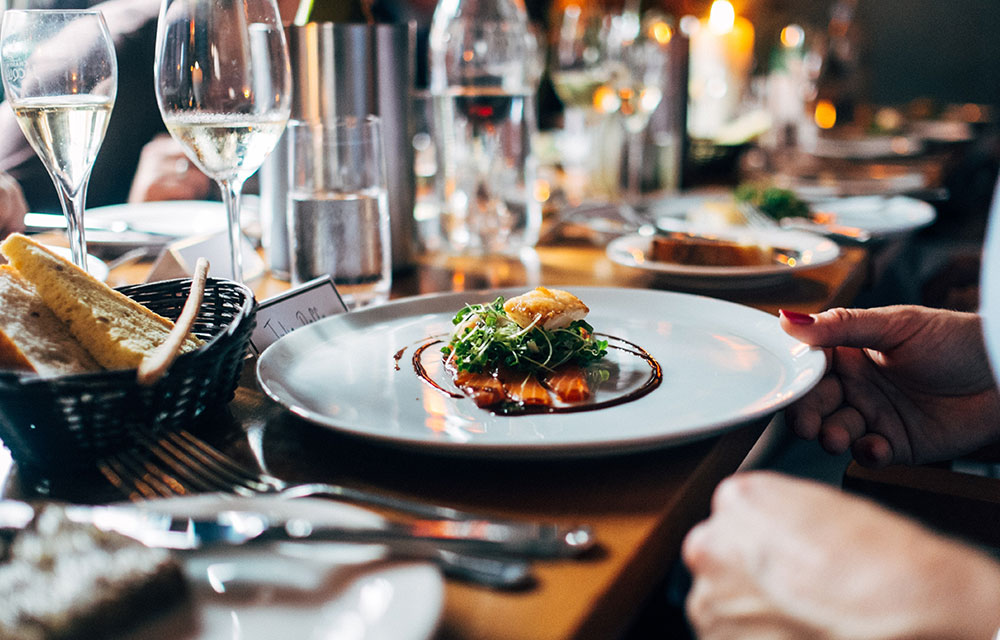Instagram might seem like a simple app – post pretty pictures, get likes – but that straightforward, traditional usage might offer diminishing returns to small businesses like restaurants, especially as organic reach on the platform continues to decline. Fortunately for marketers and others charged with managing the social media presence of any small business, several tools and spaces hidden in Instagram’s easy-to-understand interface offer plenty of flexibility and room for creativity.
As a hospitality marketing agency, we’re always seeking new ways to reach audiences by looking where others haven’t. Inspired by a tweet, we had an idea for how a restaurant could repurpose their Instagram account into a sort of “Ultimate Menu” – one that takes over your entire feed, is easy to update in real time, is interactive and easy to explore (and share!) for customers, and provides plenty of context for each dish, making it very useful. Here’s how it would work:
Your Feed Would Be Comprised Entirely of Dishes
Each dish would take up one “line” of your Instagram feed, occupying three photos. The photo on the left would show the name of the dish, and the center and right photos would be one big image of the dish. Customers would stumble upon (or purposefully navigate to) your account and be able to scroll through your offerings in a highly visual way instantly, and quickly understand exactly what you have to offer.

Individual Photos Would Provide Plenty of Context
Diners could ask questions about specific dishes in the comment section of individual photos. You, as the restaurant, or other customers could answer them. If a dish looked appetizing to someone browsing your feed, they could tap one of the photos and instantly understand much more about it, based on community feedback. Also: your captions would be significant. It’s there that you would creatively describe the dish, maybe include a quote from your chef, mention any dietary restrictions that it does or doesn’t satisfy, and share a unique hashtag (#amazingburgeratyourrestaurant) that links it together with the other two photos in your feed that represent that dish.
Dishes Would Be Shareable and Up-to-Date
If a customer ate at your restaurant, thought you had the best burger in town, and had a friend who loves burgers, they could easily tag that person (“you have to try this!”) in the comments. If you pull a dish off the menu, you could simply archive the three photos of the dish, or bring them back months later, if the dish is seasonal or part of a rotating menu. If you have something new to add to the menu, simply post a new line (those three photos) to your feed. That alone – the excitement of a new dish, made apparent by its presence in your feed – may nudge customers to come in or give it a look. The purity and straightforward nature of your feed would make your new posts more interesting to followers.
Hashtags in Your Bio Would Make it *Really* Easy to Browse
You could use hashtags to spotlight dishes that satisfy dietary requirements and link those hashtags in your bio. Maybe you have #veganatrestaurantname, #glutenfreeatrestaurantname, #paleoatrestaurant name, etc. You could remove hashtags from (or add them to) individual photos whenever you want, based on what you want to feature at that moment. Hashtags would enable people to quickly tap to see what they could eat based on their dietary preferences. The hashtag system would also work for specific parts of the meal – #saladsatrestaurantname, #appetizersatrestaurantname, #brunchatrestaurantname, etc. (By the way – while we’re on the subject of your bio – if you have OpenTable, consider making that the link in your bio. With the Ultimate Menu, people wouldn’t need to go to your website, so you may as well save them a step.)
Stories Highlights Would Do the Rest
Your Stories Highlights would spotlight everything beyond the main course that someone might want to know about your restaurant: “Drinks,” “Weekly Specials,” “Inside the Restaurant,” and “Our Team,” to name a few. Stories Highlights have long been part of Instagram best practices for restaurants, but some go overboard (including unimportant or disorganized content), while others don’t do enough. The goal – between your bio, the menu in the feed, and the Stories Highlights – would be to answer every curiosity that someone had about your restaurant, instantly, all within your account.
…So, Why Not Try It?
As far as we can tell, nobody else is using the “Ultimate Menu” Instagram approach yet. If executed well, changing course and going this route would certainly make your Instagram account more accessible and useful to people and could drive more business – plus, it would be easy to switch up if you weren’t happy with the results. If you’re starting from scratch and just beginning to explore how to use Instagram for restaurants, this would be a logical – and bold – place to begin your efforts.


